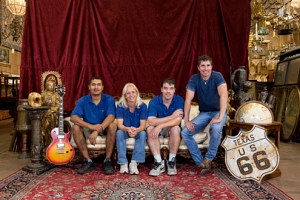Another entry in the slew of antiques and collectibles television programming is the Discovery Channel’s Auction Kings, airing Tuesday nights.
 This collecting reality show focuses on the world of auctions via the activities of Gallery 63, a consignment auction house in Atlanta, Georgia, owned by Paul Brown.
This collecting reality show focuses on the world of auctions via the activities of Gallery 63, a consignment auction house in Atlanta, Georgia, owned by Paul Brown.
As far as the personality aspect of the show, the cast of Auction Kings, aka the crew of Gallery 63, is amiable enough. Unlike some shows where part of the appeal is the characters and how they interact, the folks on Auction Kings may be a bit too affable… They do joke around and challenge one another, so it seems like a nice place to work; but they lack the edge of say Pawn Stars or the chemistry of the American Pickers. (Cindy Shook, the manager, is probably my favorite because she’s a racy lady!)
A show strength lies in the usual collecting show format: the brief educational segments on history and identification, often comprising of those appearances by experts in specific areas of collectibles.
Additionally, segments on Auction Kings often show some of the necessary behind the scenes work that many collectors and bidders forget about when they include Delfino Ramos, the handyman, tackling repairs — including on items he’s never seen before. While this isn’t a detailed “how to” segment, viewers get an idea of how easy or complicated repairs are, and therefore can consider that effort (or the charge by a professional) when evaluating antiques and collectibles. This is helpful for collectors at every level.
However, the best part of Auction Kings is the fact that this show is focused on auctions themselves. Because auctions are spontaneous, surprising things!
While Hollywood Treasure is also focused on auctions, movie memorabilia and collectibles is a very specific niche — and those auctions are for icons of film, which means higher prices. Auction Kings, on the other hand, shows general auctions. There are rare gems, but there’s also a lot of “everything else.”
From a rather unremarkable pair of cheetah print chairs (which may or may not have once been in a brothel) to a book authenticated as previously owned — and signed — by John Hancock; from a case of Billy Beer to an antique Venetian mirror; from retro arcade games to an ancient hand canon; Gallery 63 gets it all.
And viewers can learn about it.
 As every fan of auctions knows and the show says, over and over again, “you never know what will show up at an auction,” or what it will go for at an auction. This is shown via the end of the show recaps, in which you are shown the item, its appraised value or auction estimate, what the owner/seller hopes to get for the item, and the final value at the end of the auction.
As every fan of auctions knows and the show says, over and over again, “you never know what will show up at an auction,” or what it will go for at an auction. This is shown via the end of the show recaps, in which you are shown the item, its appraised value or auction estimate, what the owner/seller hopes to get for the item, and the final value at the end of the auction.
Sometimes the seller is happily shocked, sometimes the bidder gets a steal, sometimes both the buyer and the seller are thrilled — it all comes down to their expectations. And the climate on the auction floor, of course.
In a recent episode, a man brought in a case of Billy Beer. The breweriana expert said it had no value because a lot was sold and everyone saved it thinking it would be valuable one day. But they were going to auctioned it off anyway because the beer is no longer tasty (If it ever was?) and the owner didn’t care what it sold for. This prompted a bet between Shook, the manager, and new employee Jon Hammond, “The Picker.”
Hammond thought the case of Billy Beer would sell for $100 or more, even after Shook told him what the expert had said. They wagered a six-pack of fresh beer on the auction results — and Shook lost when it sold for $100. So you could say that the newbie knew more than the more experienced folks. Or he just got lucky. In any case, he got the free six-pack of beer. *wink*
Just another case of “You never know what will happen at an auction.” And why I like to watch Auction Kings.



















